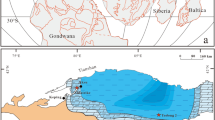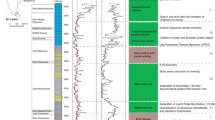Abstract
Organic carbon isotope (δ 13Corg) data from two well-preserved sections across a shallow-to-deep water transect of the late Ediacaran-Early Cambrian Yangtze Platform in South China show significant temporal and spatial variations. In the shallow-water Jiulongwan-Jijiapo section, δ 13Corg values of the late Ediacaran Dengying Formation range from −29‰ to −24‰. In the deep-water Longbizui section, δ 13Corg values from time-equivalent strata of the Dengying Formation are mostly between −35 and −32‰. These new data, in combination with δ 13Corg data reported from other sections in South China, reveal a 6‰-8 shallow-to-deep water δ 13Corg gradient. High δ 13Corg values (>−30‰) occur mostly in shallow-water carbonate rocks, whereas low δ 13Corg values (<−32‰) dominate the deep-water black shale and chert. The large temporal and spatial δ 13Corg variations imply limited buffering effect from a large dissolved organic carbon (DOC) reservoir that was inferred to have existed in Ediacaran-Early Cambrian oceans. Instead, δ 13Corg variations between platform and basin sections are more likely caused by differential microbial biomass contribution to total organic matter. High δ 13Corg values (>−30‰) documented from shallow-water carbonates are within the range of typical Phanerozoic δ 13Corg data and may record the isotope signature of organic matter from primary (photosynthetic) production. In contrast, low δ 13Corg values (<−32‰) from deep-water sections may have resulted from higher chemoautotrophic or methanotrophic biomass contribution to bulk organic matter in anoxic environments. The δ 13Corg data provide indirect evidence for ocean stratification and episodic chemocline fluctuations in the Ediacaran-Early Cambrian Yangtze Platform.
Similar content being viewed by others
References
Ader M, Macouin M, Trindade R I F, et al. 2009. A multilayered water column in the Ediacaran Yangtze platform? Insights from carbonate and organic matter paired δ 13C. Earth Planet Sci Lett, 288: 213–227
Amthor J E, Grotzinger J P, Schroder S, et al. 2003. Extinction of Cloudina and Namacalathus at the Precambrian-Cambrian boundary in Oman. Geology, 31: 431–434
Chang H J, Chu X L, Feng L J, et al. Iron speciation in cherts from the Laobao Formation, South China: Implications for anoxic and ferruginous deep-water conditions. Chin Sci Bull, 2010, 55: 3189–3196
Chen D, Wang J, Qing H, et al. 2009. Hydrothermal venting activities in the Early Cambrian, South China: Petrological, geochronological and stable isotopic constraints. Chem Geol, 258: 168–181
Chen J Y, Bottjer D J, Oliveri P, et al. 2004. Small bilaterian fossils from 40 to 55 million years before the Cambrian. Science, 305: 218–222
Chen P. 1984. Discovery of Lower Cambrian small shelly fossils from Jijiapo, Yichang, West Hubei and its significance (in Chinese). Prof Pap Stratigr Palaeontol, 13: 49–66
Condon D, Zhu M Y, Bowring S, et al. 2005. U-Pb ages from the Neoproterozoic Doushantuo Formation, China. Science, 308: 95–98
Conway N M, Kennicutt M C, Van Dover C L. 1994. Stable isotopes in the study of marine chemosynthetic-based food webs. In: Lajtha K, Michener R, eds. Stable Isotopes in Ecology and Environmental Science. Oxford: Blackwell Scientific Publications. 158–186
Derry L A. 2010. A burial diagenesis origin for the Ediacaran Shuram-Wonoka carbon isotope anomaly. Earth Planet Sci Lett, 294: 152–162
Des Marais D J, Strauss H, Summons R E, et al. 1992. Carbon isotope evidence for the stepwise oxidation of the Proterozoic environment. Nature, 359: 605–609
Ding L, Li Y, Chen H. 1992. Discovery of Micrhystridium regulare from Sinian-Cambrian boundary strata in Yichang, Hubei, and its stratigraphic significance (in Chinese). Acta Palaeontol Sin, 9: 303–309
Dong L, Xiao S H, Shen B, et al. 2009. Basal Cambrian microfossils from the Yangtze gorges area (South China) and the Aksu area (Tarim block, northwestern China). J Paleontol, 83: 30–44
Galimov E M. 2004. The pattern of δ 13Corg versus HI/OI relation in recent sediments as an indicator of geochemical regime in marine basins: Comparison of the Black Sea, Kara Sea, and Cariaco Trench. Chem Geol, 204: 287–301
Grotzinger J P, Fike D A, Fischer W W. 2011. Enigmatic origin of the largest-known carbon isotope excursion in Earth’s history. Nature Geosci, 4: 285–292
Guo H, Du Y, Kah L C, et al. 2013. Isotopic composition of organic and inorganic carbon from the Mesoproterozoic Jixian Group, North China: Implications for biological and oceanic evolution. Precambrian Res, 224: 169–183
Guo Q J, Strauss H, Liu C Q, et al. 2007. Carbon isotopic evolution of the terminal Neoproterozoic and Early Cambrian: Evidence from the Yangtze platform, South China. Palaeogeogr Palaeoclimatol Palaeoecol, 254: 140–157
Harris D, Horwath W R, van Kessel C. 2001. Acid fumigation of soils to remove carbonates prior to total organic carbon or Carbon-13 isotopic analysis. Soil Sci Soc Am J, 65: 853–1856
Hayes J M, Strauss H, Kaufman A J. 1999. The abundance of 13C in marine organic matter and isotopic fractionation in the global biogeochemical cycle of carbon during the past 800 Ma. Chem Geol, 161: 103–125
Hollander D J, Smith M A. 2001. Microbially mediated carbon cycling as a control on the δ 13C of sedimentary carbon in eutrophic Lake Mendota (USA): New models for interpreting isotopic excursions in the sedimentary record. Geochim Cosmochim Acta, 65: 4321–4337
Hua H, Chen Z, Yuan X L, et al. 2005. Skeletogenesis and asexual reproduction in the earliest biomineralizing animal Cloudina. Geology, 33: 277–280
Ishikawa T, Ueno Y, Komiya T, et al. 2008. Carbon isotope chemostratigraphy of a Precambrian/Cambrian boundary section in the Three Gorge area, South China: Prominent global-scale isotope excursions just before the Cambrian Explosion. Gondwana Res, 14: 193–208
Ishikawa T, Ueno Y, Shu D G, et al. 2013. Irreversible change of the oceanic carbon cycle in the earliest Cambrian: High-resolution organic and inorganic carbon chemostratigraphy in the Three Gorges area, South China. Precambrian Res, 225: 190–208
Jacobsen S B, Kaufman A J. 1999. The Sr, C and O isotopic evolution of Neoproterozoic seawater. Chem Geol, 161: 37–57
Jiang G, Shi X, Zhang S, et al. 2011. Stratigraphy and paleogeography of the Ediacaran Doushantuo Formation (ca. 635-551 Ma) in South China. Gondwana Res, 19: 831–849
Jiang G, Wang X, Shi X, et al. 2012. The origin of decoupled carbonate and organic carbon isotope signatures in the early Cambrian (ca. 542-520 Ma) Yangtze Platform. Earth Planet Sci Lett, 317–318: 96–110
Jiang G, Kaufman A J, Christie-Blick N, et al. 2007. Carbon isotope variability across the Ediacaran Yangtze Platform in South China: Implications for a large surface-to-deep ocean δ 13C gradient. Earth Planet Sci Lett, 261: 303–320
Jiang G, Sohl L E, Christie-Blick N. 2003. Neoproterozoic stratigraphic comparison of the Lesser Himalaya (India) and Yangtze block (South China): Paleogeographic implications. Geology, 31: 917–920
Jiang G, Wang X, Shi X, et al. 2010. Organic carbon isotope constraints on the dissolved organic carbon (DOC) reservoir at the Cryogenian-Ediacaran transition. Earth Planet Sci Lett, 299: 159–168
Johnston D T, Macdonald F A, Gill B C, et al. 2012. Uncovering the Neoproterozoic carbon cycle. Nature, 483: 320–323
Kaufman A J, Knoll A H. 1995. Neoproterozoic variations in the C-isotopic composition of seawater: Stratigraphic and biogeochemical implications. Precambrian Res, 73: 27–49
Kimura H, Matsumoto R, Kakuwa Y, et al. 1997. The Vendian-Cambrian δ 13C record, North Iran: Evidence for overturning of the ocean before the Cambrian Explosion. Earth Planet Sci Lett, 147: E1–E7
Knauth L P, Kennedy M J. 2009. The late Precambrian greening of the Earth. Nature, 460: 728–732
Kouchinsky A, Bengtson S, Pavlov V, et al. 2007. Carbon isotope stratigraphy of the Precambrian-Cambrian Sukharikha River section, northwestern Siberian platform. Geol Mag, 144: 609–618
Lehmann M F, Bernasconi S M, Barbieri A, et al. 2002. Preservation of organic matter and alteration of its carbon and nitrogen isotope composition during simulated and in situ early sedimentary diagenesis. Geochim Cosmochim Acta, 66: 3573–3584
Li C, Love G D, Lyons T W, et al. 2010. A stratified redox model for the Ediacaran Ocean. Science, 328: 80–83
Lu M, Zhu M, Zhang J M, et al. 2013. The DOUNCE event at the top of the Ediacaran Doushantuo Formation, South China: Broad stratigraphic occurrence and non-diagenetic origin. Precambrian Res, 225: 86–109
Maloof A C, Ramezani J, Bowring S A, et al. 2010. Constraints on early Cambrian carbon cycling from the duration of the Nemakit-Daldynian-Tommotian boundary δ 13C shift, Morocco. Geology, 38: 623–626
McFadden K A, Huang J, Chu X L, et al. 2008. Pulsed oxidation and bioloical evolution in the Ediacaran Doushantuo Formation. Proc Natl Acad Sci USA, 105: 3197–3202
Qian Y. 1999. Taxonomy and Biostratigraphy of Small Shelly Fossils in China (in Chinese). Beijing: Science Press. 247
Rooney M A, Claypool G E, Chung H M. 1995. Modeling thermogenic gas generation using carbon isotope ratios of natural gas hydrocarbons. Chem Geol, 126: 219–232
Sahoo S K, Planavsky N J, Kendall B, et al. 2012. Ocean oxygenation in the wake of the Marinoan glaciation. Nature, 489: 546–549
Schrag D P, Higgins J A, Macdonald F A, et al. 2013. Authigenic carbonate and the history of the global carbon cycle. Science, 339: 540–543
Shen Y N, Zhang T G, Hoffman P F. 2008. On the coevolution of Ediacaran oceans and animals. Proc Natl Acad Sci USA, 105: 7376–7381
Steiner M, Li G X, Qian Y, et al. 2007. Neoproterozoic to early Cambrian small shelly fossil assemblages and a revised biostratigraphic correlation of the Yangtze Platform (China). Palaeogeogr Palaeoclimatol Palaeoecol, 254: 67–99
Summons R, Franzmann P D, Nichols P D. 1998. Carbon isotopic fractionation associated with methylotrophic methanogenesis. Org Geochem, 28: 465–475
Summons R E, Jahnke L L, Roksandic Z. 1994. Carbon isotope fractionation in lipids from methanotrophic bacteria: Relevance for interpretations of the geochemical record of biomarkers. Geochim Cosmochim Acta, 58: 2853–2863
Swanson-Hysell N L, Rose C V, Calmet C C, et al. 2010. Cryogenian glaciation and the onset of carbon-isotope decoupling. Science, 328: 608–611
Wang J G, Chen D Z, Yan D T, et al. 2012. Evolution from an anoxic to oxic deep ocean during the Ediacaran-Cambrian transition and implications for bioradiation. Chem Geol, 306-307: 129–138
Wang L, Shi X, Jiang G. 2012. Pyrite morphology and redox fluctuations recorded in the Ediacaran Doushantuo Formation. Palaeogeogr Palaeoclimatol Palaeoecol, 333-334: 218–227
Wang W, Zhou C, Yuan X, et al. 2012. A pronounced negative δ 13C excursion in an Ediacaran succession of western Yangtze Platform: A possible equivalent to the Shuram event and its implication for chemostratigraphic correlation in South China. Gondwana Res, 22: 1091–1101
Wang X, Shi X, Jiang G, et al. 2012. New U-Pb age from the basal Niutitang Formation in South China: Implications for diachronous development and condensation of stratigraphic units across the Yangtze platform at the Ediacaran-Cambrian transition. J Asian Earth Sci, 48: 1–8
Xiao S H, Shen B, Zhou C M, et al. 2005. A uniquely preserved Ediacaran fossil with direct evidence for a quilted bodyplan. Proc Natl Acad Sci USA, 102: 10227–10232
Yin L M. 1997. Precambrian-Cambrian transitional acritarch biostratigraphy of the Yangtze Platform. Bull Natl Mus Nat Sci (Taipei), 10: 217–231
Yin L M, Zhu M Y, Knoll A H, et al. 2007. Doushantuo embryos preserved inside diapause egg cysts. Nature, 446: 661–663
Yuan X, Chen Z, Xiao S, et al. 2011. An early Ediacaran assemblage of macroscopic and morphologically differentiated eukaryotes. Nature, 470: 390–393
Zhou C M, Xiao S H. 2007. Ediacaran δ 13C chemostratigraphy of South China. Chem Geol, 237: 89–108
Zhu M, Gehling J G, Xiao S, et al. 2008. Eight-armed Ediacara fossil preserved in contrasting taphonomic windows from China and Australia. Geology, 36: 867–870
Zhu M, Lu M, Zhang J M, et al. 2013. Carbon isotope chemostratigraphy and sedimentary facies evolution of the Ediacaran Doushantuo Formation in western Hubei, South China. Precambrian Res, 225: 7–28
Zhu M, Zhang J, Yang A. 2007. Integrated Ediacaran (Sinian) chronostratigraphy of South China. Palaeogeogr Palaeoclimatol Palaeoecol, 254: 7–61
Author information
Authors and Affiliations
Corresponding author
Electronic supplementary material
Rights and permissions
About this article
Cite this article
Wang, X., Shi, X., Jiang, G. et al. Organic carbon isotope gradient and ocean stratification across the late Ediacaran-Early Cambrian Yangtze Platform. Sci. China Earth Sci. 57, 919–929 (2014). https://doi.org/10.1007/s11430-013-4732-0
Received:
Accepted:
Published:
Issue Date:
DOI: https://doi.org/10.1007/s11430-013-4732-0




